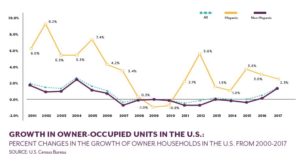As a member and a leader of the NAHREP (National Association of Hispanic Real Estate Professionals) Denver chapter, I have the chance to have access to insights regarding information about homeownership trends and specifically, as it related to the Hispanic community. On the of the more telling documents is the State of Hispanic Homeownership Report which is published annually by NAHREP and the Hispanic Wealth Project. I would like to share some highlights from the 2017 report.
Hispanic Population and Household Formation Trends
- While the fastest growing Hispanic markets are in locations such as Russell County, AL; Bryan County, GA; and Luzerne County, PA, more than half of the country’s Hispanic population continues to be located in California (15.3 million), Texas (10.9 million) and Florida (5.1 million).
- Hispanics are projected to lead U.S. household growth, adding 6 million additional Hispanic households by 2024.
- 6% of total U.S. household formations or 265,000 in 2017 were Hispanic
Homeownership
- In 2017, 7,472,000 Hispanics owned a home, an increase of 167,000 from 2016’s numbers.This increase equates to a Hispanic homeownership rate of 46.2 % for 2017, an increase of 0.2 % from 2016’s percentage. Hispanics are the only demographic to have increased their rate of homeownership for the last three consecutive years.
- Hispanics are the only demographic to have increased their rate of homeownership for the last three consecutive years.
- In Colorado, the Hispanic share of population based on a five year estimate is 21.1%. Of that population, the homeownership Rate is 48.1%. The Hispanic unemployment rate is 4.7% and median household income is $49,201. This income leaves the entry level purchase price of $300,000 out of range for the median household income.
Consumer Attitudes
The following stats come from Fannie Mae’s October – November 2017 attitudinal survey regarding Hispanic consumer sentiment on the housing industry and homeownership:
- Most Hispanics (60 %) indicated that they expect their personal financial situation to improve, despite concerns by about half (51 %) that the economy is on the wrong track.
- One in four (25 %) Hispanics believed it was a good time to buy a home because there are many homes available on the market, even though 40 % feel home prices are high.
- Most Hispanics (78 %) believe owning a home allows more control over one’s living space.
- Most Hispanics (81 %) agree that owning a home is a good investment long term.
- Most Hispanics (56 %) believe it is difficult to get a home mortgage today.
- About half of Hispanics (51 %) believe home prices and mortgage rates will rise this year.
- Hispanics continue to prefer homeownership to renting with 88 % indicating that in the future they are more likely to own a home than rent.
Hispanic Consumer Nuances
- Language is an important consideration for Hispanics, especially Millennials, in selecting brands with which to interact. In contrast to prior generations where language dominance was largely a function of how recently they had immigrated to the U.S., Hispanics are increasingly bilingual by choice. Of U.S. Hispanics, 54.2 % are bilingual and only 18.2 % are Spanish dominant.
- More Hispanic Millennials (32 %) also live at home with their parents than in any other living arrangement
- Hispanics, especially Millennials, are huge consumers of mobile. They make use of smart phones for various purposes. As savvy, price conscious consumers, 92% of Hispanic Millennials use coupons, and 81 % are influenced to select where to shop based on the retailer’s offer of digital coupons.
External Obstacles to Hispanic Homeownership
The continued shortage of affordably priced homes, coupled with prolonged natural disasters concentrated in the nation’s most populous Latino states, and increasing uncertainty over immigration policy, have created significant hurdles for Latino homeownership and economic saliency.
- The crisis level inventory shortage must be managed to enable construction of affordable housing stock. The continued development of new homes outside of the affordable price ranges – to the near exclusion of building affordable housing stock – puts in place an unsustainable growth strategy for the nation’s housing economy and is increasingly making homeownership affordable only to the wealthy.
- Deferred Action for Childhood Arrivals (DACA) and Temporary Protected Status (TPS) recipients had obtained legal status by virtue of their respective designations. There are approximately 800,000 approved DACA recipients and potentially as many as 1.8 million eligible for DACA.58 The reasonable assumption is that legal status provides increased opportunity, a chance at stable economic conditions, and the potential for improved long-term trajectory.
- Natural disaster related damage in California, Texas, Florida, and Puerto Rico began with the Summer wildfires and continued in August with hurricanes and flooding, persisting through the end of the year. While data associated with the long term effects are still being collected, the fact that these disasters occurred in states and locations with the country’s highest Hispanic populations undoubtedly had an effect on the potential for even greater gains in those locations and for Hispanic homeownership overall.
Download the report to read the all the details on each of the sections summarized in this article.
As always you can contact me by email or call 303-728-9433 if interested in buying or selling your home.
Rogelio Rodriguez
Vida Real Properties and Services, LLC



